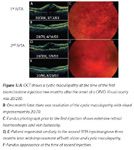Identifying a treatment for macular oedema secondary to CRVO
A review of the various studies that have investigated the best way to treat macular oedema secondary to CRVO.

More recently, several smaller series have described improvements in both macular thickness and VA in patients treated with intravitreal triamcinolone acetonide (IVTA).6-13 The purpose of this article is to review the safety and efficacy of IVTA for the treatment of macular oedema secondary to CRVO and to discuss other, more recent, approaches to the management of this common retinal vascular condition.
Let's look at the case for triamcinolone
By one year postoperatively, 50% of eyes had received more than one injection (mean number of injections 1.6; range 1- 4). There was some overall improvement in VA within the first six months but this was not sustained at one year. Median VA change was +1 line at one and three months and no lines at six and 12 months. The VA outcomes were slightly worse when patients with extremely poor baseline VA (worse than 20/400) were removed from the analysis. At three and six months, the median VA change from baseline was no lines, and at 12 months the median VA change from baseline was -1 line.
Our one-year VA results were essentially no different to the one-year results of the Central Vein Occlusion Study; the largest study to evaluate the natural history and treatment of CRVO.1 In the macular oedema treatment group (group M) of the Central Vein Occlusion Study, the mean VA change in the untreated group (78 control eyes) was -1 letter at four months and -3 letters at 12 months.2

